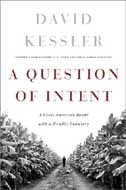David Kessler’s A Question of Intent (New York, Public Affairs 2001) is a compelling, riveting, yet ultimately deeply troubling book. It is at times dry, at other times as absorbing as a Dashiell Hammett novel. It is part memoir, part detective story. This book is bound to leave readers feeling outraged with executives at tobacco companies, food companies, drug manufacturers, advertising agencies and law firms, as well as with elected representatives in the U.S. Congress. In the fall of 1990, thirty-nine-year-old Kessler, now the Dean of Yale Medical School, was called by the first Bush administration to serve as commissioner of the Food and Drug Administration. Trained both as a physician at Harvard Medical School and as a lawyer at the University of Chicago, Kessler had taught food and drug law at Columbia, and was the medical director of Albert Einstein Hospital in the Bronx when the call came from Washington. With no obvious political axe to grind, Kessler took over an agency that he described as “underfunded, understaffed, and demoralized”. Congress had given the FDA a wide mandate to regulate food, drugs, and cosmetics. It had an impact on one of every four dollars consumers spent. Kessler found himself initially focusing on the food industry. In the early 1990s companies were trumpeting their products’ “freshness”. After a lengthy investigation, Kessler’s staff concluded that Proctor & Gamble’s Citrus Hill Orange Juice had gone too far in labeling its product “Fresh Choice” and using the words “pure squeezed 100% orange juice” in considerably larger type than the words “from concentrate”. In fact, the FDA found that juice was squeezed from a blend of oranges, reduced to concentrate through evaporation, and then some months later, “water was added back, along with orange oil, orange pulp, and something described as ‘orange essence’, in an attempt to restore flavor.” The FDA warned P&G that the company’s claim of “fresh” was false and misleading. P&G shrugged off the warning, responding that its process and labeling was no different from any other juice producer. Kessler learned quickly that the FDA was perceived to be a toothless tiger, which few companies took seriously. He asked his staff what the next step was after a company failed to make changes required by the FDA. “Seizure of the products” was the response. Later that day, Kessler gave a speech to food industry lawyers who were attending a conference in Florida. It was obvious to Kessler that his audience was more interested in golf than they were in what he had to say. As visions of birdies danced in their heads, Kessler brought them all back to reality with his announcement that earlier that day Procter & Gamble’s Citrus Hill orange juice had been seized on the grounds that “the use of the term “fresh” was false and misleading. Kessler was matter of fact in his pronouncement: “Today’s actions will send a clear message that the FDA will not tolerate such violations of the law.” Kessler was no zealot; rather, he was simply doing what he believed his job required of him. He was intent on enforcing the laws Congress had enacted to protect public health. After a few skirmishes with the food industry, Kessler found his attention turned to the tobacco industry. Convinced that there was too much work to do in other areas of the food and drug industries, Kessler had given tobacco little, if any, thought. The industry itself opened the door to scrutiny in the late 1980s when R. J. Reynolds attempted to develop Premier, a smokeless cigarette. Premier had virtually no tobacco and was essentially a high-tech nicotine delivery system. The product never made it into the marketplace, but the notion that cigarettes were “nicotine delivery devices” raised questions in the minds of some of Kessler’s staff. Nicotine was acknowledged to be a highly addictive drug. It was clear to the FDA staff that any type of “nicotine delivery device” would be subject to FDA scrutiny and regulation. By 1991, health officials were painfully aware that smoking-related illnesses were responsible for hundreds of thousands of deaths each year and millions of cases of serious illness. Smoking had become a public health crisis in the minds of many people. Kessler was hesitant at first. He knew the dangers of smoking, but he also knew that there was no more powerful industry than tobacco. The industry had virtually limitless financial resources, which gave it unmatched influence on Capitol Hill. The tobacco industry spared no expense in retaining the services of the best minds in advertising, public relations, and law. Indeed, the industry had over the years developed an enviable record for recruiting former commissioners of the FDA to work for them either directly or indirectly through prominent law firms. Kessler feared that tackling the tobacco industry would monopolize his own time and the resources of too many people within the agency. The industry’s own hubris and ham-handed behavior, however, simplified matters for the FDA. Premier helped Kessler and his staff shift their focus from the proscription of tobacco to the prescription of nicotine as an addictive drug. The relevant section of the federal law defined a drug as “articles (other than food) intended to affect the structure or function of the body.” As Kessler writes, there were two parts to this definition: “A substance not only had to affect the structure or function of the body, but the manufacturer had to intend that it do so.” It was the question of intent to which Kessler would turn his focus for the next five years. Despite their earlier adamant denials and protestations, the tobacco companies have long known of the addictive characteristics of nicotine. A memo written in the early 1970s by an executive of R. J. Reynolds was typical of what Kessler and his staff found lurking in tobacco company files: “Nicotine is known to be a habit-forming alkaloid…Thus, a tobacco product is, in essence a vehicle for delivery of nicotine….Our industry is then based upon the design, manufacture, and sale of attractive dosage forms of nicotine, and our Company’s position in the industry is determined by our ability to produce dosage forms of nicotine which have more overall value, tangible or intangible, to the consumer than those of our competitors.” The tobacco companies built their marketing campaigns on addiction, with a singular focus on grabbing potential smokers in their teens, when men and women were most likely to try smoking. The tobacco industry juggernaut fought Kessler every step of the way. Discovery of unsavory facts came slowly at first, initially through informants who feared for their very lives. The combination of the FDA’s investigation, the action by state attorneys-general, and civil suits produced truckloads of damning evidence, most of it from the industry’s own files. Kessler paints a picture of companies filled with bright executives from the best schools who were willing to stop at nothing to sell their company’s product. Financial considerations and questions of market share predominated, leaving no room for ethical or moral considerations. To this day, even as the tobacco companies disingenuously claim that they do not want young people in this country to smoke, they are gearing up production and marketing to lure potential addicts in Europe, Asia, and other parts of the world where regulation is less burdensome. Tobacco executives have staked out as their last patch of turf “freedom to choose.” More quietly, they (and their lawyers) are saying that smokers know the risk. But so too do the executives who run these companies. Kessler has provided readers with a powerful picture of an industry built on the intent to deceive, the intent to manipulate, and the intent to addict. Kessler’s prefatory quote from the “Odes of Horace” captures the vivid story that unfolds in this book: “The guilty have a head start, and retribution is always slow of foot, but it catches up.”
Looking for more insights?
Sign up to stay informed about our latest article releases.


